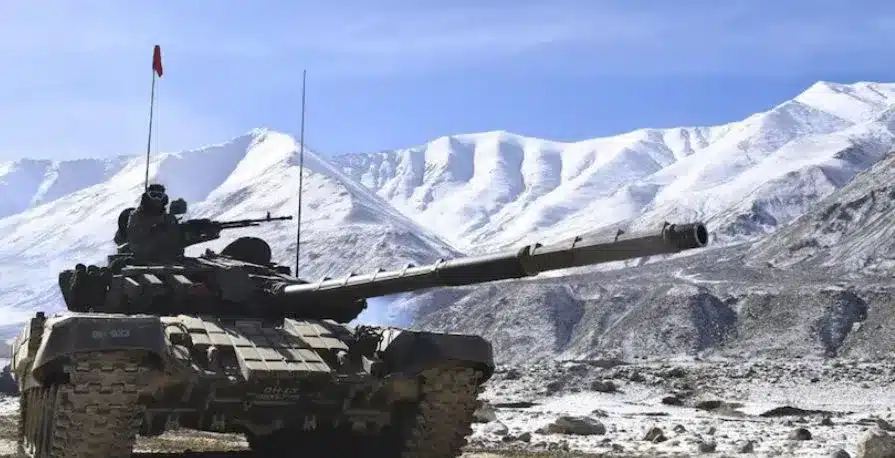What’s in today’s article?
- Why in News?
- Background: Road to agreement
- Patrolling Pact: A Key Element of the Agreement
- Key highlights of the agreement
- Diverging Interpretations
Why in News?
Indian and Chinese negotiators have reached an agreement on “patrolling arrangements” along the Line of Actual Control (LAC), leading to a disengagement and resolution of the tensions that emerged in 2020. The announcement was made by India, highlighting progress in the management of the border dispute.
The agreement was followed by a bilateral meeting between Indian Prime Minister Narendra Modi and Chinese President Xi Jinping during the BRICS leaders’ summit in Kazan, Russia.
Background: Road to agreement
- PM Modi’s Call for Improved Relations with China
- In April 2024, PM Modi, in an interview, emphasized the significance of India’s relationship with China.
- He highlighted the need to urgently address the prolonged border situation to normalize bilateral interactions.
- Positive Response from China
- In response, the Chinese government expressed a positive outlook.
- A spokesperson from the Chinese Foreign Ministry acknowledged that India-China relations encompass more than just the border dispute.
- Indian Foreign Minister’s Focus on Patrolling Rights (May 2024)
- In May 2024, Indian EAM S. Jaishankar expressed optimism regarding the resolution of remaining border disputes with China, particularly in the Ladakh region.
- He emphasized that the key issues still in contention were related to “patrolling rights” and “patrolling abilities” along the disputed areas.
Patrolling Pact: A Key Element of the Agreement
- Significance
- The patrolling agreement is a crucial aspect of the border management deal between India and China.
- It is central to maintaining stability and order along the disputed areas of the Line of Actual Control (LAC).
- Patrolling Dynamics on the India-China Border
- Patrolling is vital in the India-China border management system due to the absence of a clear physical demarcation on the ground.
- Indian troops regularly patrol up to the Indian-perceived border and then return to their base.
- During these patrols, soldiers leave behind indicators of their presence, such as Indian-made items like cigarette packets or matchboxes.
- Article 4 of the 2005 Border Pact: Guidelines for Troop Conduct
- The 2005 border agreement, particularly Article 4, provides guidelines for handling face-offs between Indian and Chinese troops:
- Self-Restraint in Face-offs: Both sides are required to exercise restraint and take necessary measures to prevent escalation if there is a face-to-face encounter due to differing perceptions of the LAC.
- No Use of Force: Neither side shall use or threaten to use force during such encounters.
- Mutual Courtesy and No Provocative Actions: Troops must treat each other courteously and avoid any actions that could provoke tensions.
- Prohibition on Markings: Neither side is allowed to place marks or signs at the confrontation points.
Key highlights of the agreement
- Restoration of Patrolling Rights in Depsang Plains and Demchok
- India and China have agreed to restore mutual patrolling rights in the Depsang Plains and the Demchok region, areas with disputes predating the 2020 incursions.
- Indian troops will now be allowed to patrol up to Patrolling Points (PP) 10 to 13 in the Depsang Plains and the Charding Nullah in Demchok.
- However, areas where previous disengagements occurred—such as Galwan Valley, Pangong Tso, and Gogra-Hot Springs—are not open for renegotiation.
- This agreement is seen as a step toward resolving long-standing legacy issues.
- Process of Disengagement, De-escalation, and Demilitarization
- The agreement is expected to initiate a process of disengagement, de-escalation, and demilitarization in the areas where both nations currently have 50,000 to 60,000 troops each.
- The phased approach of the agreement will focus first on disengagement, followed by de-escalation and eventual de-induction of forces.
- Focus on Preventing Future Clashes
- The agreement aims to prevent incidents like the 2020 Galwan clashes, which resulted in the deaths of 20 Indian soldiers and at least four Chinese soldiers.
- Future Path
- The endorsement of the agreement by Indian PM Modi and Chinese President Xi should lead to a reduction in tensions along the LAC and set the stage for normalizing relations between the two countries.
Diverging Interpretations
- Difference
- Following the meeting between PM Modi and President Xi Jinping, differences in interpretation emerged.
- India’s statement emphasized a “complete disengagement and resolution of issues that arose in 2020.
- On the other hand, China’s statement highlighted “important progress” on resolving relevant border issues, reflecting a more cautious tone.
- Contrasting Views on the Impact of the Border Dispute
- India has reiterated that the border standoff must be resolved before normalizing bilateral ties, indicating no “business as usual” until then.
- In contrast, China maintains that the border issue should not affect broader relations, suggesting it prefers a compartmentalized approach.
- Planned Steps for Resolving the Border Dispute
- Indian side mentioned that Special Representatives would soon meet to seek a fair, reasonable, and mutually acceptable solution to the boundary question.
- Meanwhile, China’s statement suggested future talks at multiple diplomatic levels to restore relations to sound and steady development.
Conclusion: Cautious Optimism in India’s Strategic Circles
- There is cautious optimism in India about the path forward, acknowledging that the border agreement has initiated a trust-building process.
- The three-step process—disengagement, de-escalation, and de-induction—is expected to take at least a couple of years to complete if both sides adhere to the agreement.
- It remains unclear whether these steps will occur in parallel or sequentially.
Q.1. What does the new India-China agreement entail?
The agreement allows restoration of patrolling rights in the Depsang Plains and Demchok, resolving disputes predating 2020. It focuses on disengagement, de-escalation, and eventual troop reduction along the Line of Actual Control (LAC).
Q.2. What are the future implications of the LAC agreement?
The LAC agreement sets a trust-building process, aiming to prevent future clashes. However, India’s cautious approach contrasts with China’s focus on broader ties, hinting at a complex negotiation path for lasting resolution.
News: India-China LAC Agreement: What this means, why experts are advising caution
Last updated on December, 2025
→ Check out the latest UPSC Syllabus 2026 here.
→ Join Vajiram & Ravi’s Interview Guidance Programme for expert help to crack your final UPSC stage.
→ UPSC Mains Result 2025 is now out.
→ UPSC Notification 2026 is scheduled to be released on January 14, 2026.
→ UPSC Calendar 2026 is released on 15th May, 2025.
→ The UPSC Vacancy 2025 were released 1129, out of which 979 were for UPSC CSE and remaining 150 are for UPSC IFoS.
→ UPSC Prelims 2026 will be conducted on 24th May, 2026 & UPSC Mains 2026 will be conducted on 21st August 2026.
→ The UPSC Selection Process is of 3 stages-Prelims, Mains and Interview.
→ UPSC Result 2024 is released with latest UPSC Marksheet 2024. Check Now!
→ UPSC Prelims Result 2025 is out now for the CSE held on 25 May 2025.
→ UPSC Toppers List 2024 is released now. Shakti Dubey is UPSC AIR 1 2024 Topper.
→ UPSC Prelims Question Paper 2025 and Unofficial Prelims Answer Key 2025 are available now.
→ UPSC Mains Question Paper 2025 is out for Essay, GS 1, 2, 3 & GS 4.
→ UPSC Mains Indian Language Question Paper 2025 is now out.
→ UPSC Mains Optional Question Paper 2025 is now out.
→ Also check Best IAS Coaching in Delhi

















